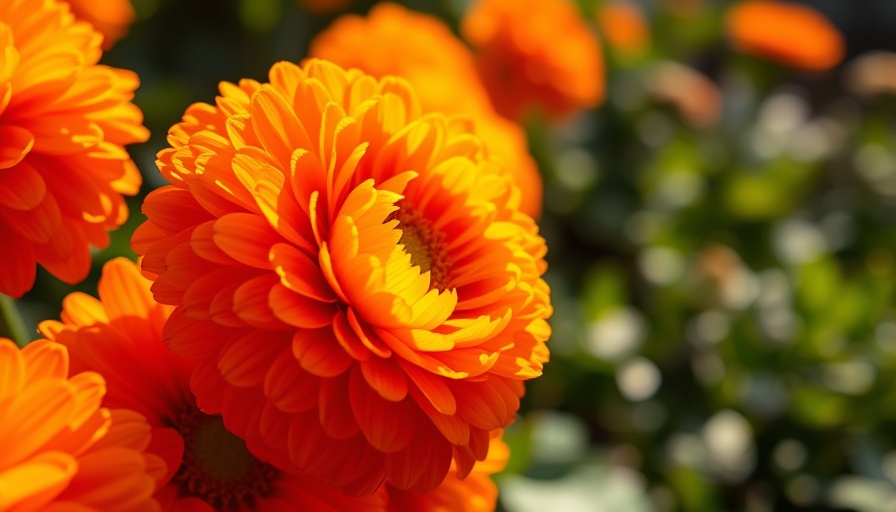
Introducing the Beautiful Ranunculus
Ranunculus flowers stand out with their lush, tissue-like petals and a palette of vivid colors that can brighten any garden. Known for their delicate beauty, these blooms boast an enchanting presence that transforms landscapes and home interiors alike. Whether you're an avid gardener or simply someone who appreciates natural beauty, learning how to grow and care for these lovely flowers can be a fulfilling endeavor.
The Ranunculus genus includes over 400 species, each contributing to the flower’s overall charm. Most familiarly, the Persian buttercup (R. asiaticus) offers an exquisite option for homeowners keen to enhance their gardens. This variety, cherished for its layered blooms reminiscent of peonies and roses, is not just visually stunning; its cultivation also fosters a deeper connection to the natural world.
Optimal Growing Conditions for Ranunculus
To cultivate ranunculus successfully, understanding their ideal growing conditions is crucial. These flowers thrive in mild climates, specifically USDA Zones 8 to 11, where they can be planted in fall. They grow through cooler months, allowing their blooms to emerge gloriously in the spring. In cooler zones, you can enjoy these beauties as annuals by planting them in early spring for vibrant late spring and early summer displays.
Key to their success is well-draining, organically rich soil coupled with ample sunlight – a balance between full and part sun exposure is best. Additionally, incorporating pest-resistant plants nearby will aid in creating a supportive ecosystem that fosters growth without the threat of common garden nuisances.
Selecting the Right Cultivars
There is a myriad of ranunculus cultivars to choose from. When selecting the right ones for your garden, consider their color range and form. From bold reds to soft pastels, ranunculus flowers can bring a sense of joy and creativity to your flower gardening projects. The vibrant Persian buttercup is a top choice, but don't overlook varieties like R. repens and R. ficaria, which are valued for their lower maintenance and utility as ground covers.
Propagation Techniques and Tips
Propagating ranunculus is a rewarding endeavor that can be achieved by planting their tuberous roots, often likened to claw-like corms. Before planting, soak these roots for a few hours to encourage growth. Then, plant them in groups for a fuller display. As they mature, ranunculus will need some attention; regular watering keeps them thriving, especially during their blooming season. Home gardeners can effectively utilize seed starting techniques for even more varieties, ensuring a bountiful harvest of beauty in the garden.
Managing Pests and Diseases
Understanding potential pest issues is essential for any gardener dedicated to preserving their floral investments. The good news? Ranunculus are relatively pest-resistant, especially when planted alongside companion plants that deter harmful insects. Common challenges include aphids and fungal diseases; thus, employing organic gardening practices is advisable, offering both a healthy plant environment and peace of mind for eco-conscious gardeners.
Best Uses for Ranunculus
Beyond their ornamental appeal, ranunculus have practical uses in floral arrangements and home decor. Their long vase life makes them ideal for cut-flower displays, allowing their vibrant colors to shine in your home. Additionally, cultivating ranunculus can foster a sense of community and self-sufficiency, as sharing blooms with neighbors or friends enriches relationships while making an everlasting impact.
Seasonal Care and Storage
As the flower season draws to a close, proper care becomes pivotal. For homeowners in colder climates, after flowering, carefully dig up the tuberous roots and store them in a cool, dry place over winter. This ensures their vitality for replanting in the upcoming spring. Employing best garden fertilizers during the growing season can significantly enhance plant health and resilience.
Time to Get Growing!
Once you've familiarized yourself with the needs and benefits of growing ranunculus, it’s time to get started! Embrace the adventure of flower gardening with these beautiful blooms. Not only will you find joy in nurturing them, but you will also contribute positively to your environment. Ready to fill your garden with color? Start learning about ranunculus today!
 Add Row
Add Row  Add
Add 




 Add Row
Add Row  Add
Add 

Write A Comment